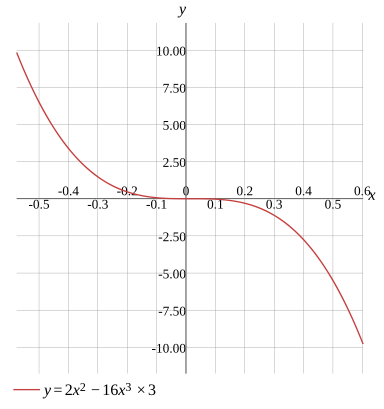Question
Function
Evaluate the derivative
Find the domain
Find the x-intercept/zero
Load more

y′=4x−144x2
Evaluate
y=2x2−16x3×3
Simplify
y=2x2−48x3
Take the derivative of both sides
y′=dxd(2x2−48x3)
Use differentiation rule dxd(f(x)±g(x))=dxd(f(x))±dxd(g(x))
y′=dxd(2x2)−dxd(48x3)
Calculate
More Steps


Calculate
dxd(2x2)
Use differentiation rule dxd(cf(x))=c×dxd(f(x))
2×dxd(x2)
Use dxdxn=nxn−1 to find derivative
2×2x
Multiply the terms
4x
y′=4x−dxd(48x3)
Solution
More Steps


Calculate
dxd(48x3)
Use differentiation rule dxd(cf(x))=c×dxd(f(x))
48×dxd(x3)
Use dxdxn=nxn−1 to find derivative
48×3x2
Multiply the terms
144x2
y′=4x−144x2
Show Solution

Testing for symmetry
Testing for symmetry about the origin
Testing for symmetry about the x-axis
Testing for symmetry about the y-axis
Not symmetry with respect to the origin
Evaluate
y=2x2−16x33
Simplify the expression
y=2x2−48x3
To test if the graph of y=2x2−48x3 is symmetry with respect to the origin,substitute -x for x and -y for y
−y=2(−x)2−48(−x)3
Simplify
More Steps


Evaluate
2(−x)2−48(−x)3
Multiply the terms
2x2−48(−x)3
Multiply the terms
More Steps


Evaluate
48(−x)3
Rewrite the expression
48(−x3)
Multiply the numbers
−48x3
2x2−(−48x3)
Rewrite the expression
2x2+48x3
−y=2x2+48x3
Change the signs both sides
y=−2x2−48x3
Solution
Not symmetry with respect to the origin
Show Solution

Solve the equation
y=2x2−48x3
Evaluate
y=2x2−16x3×3
Solution
y=2x2−48x3
Show Solution

Rewrite the equation
r=0r=48cos3(θ)cos2(θ)+cos(θ)(cos(θ)−48sin(θ))×∣cos(θ)∣r=48cos3(θ)cos2(θ)−cos(θ)(cos(θ)−48sin(θ))×∣cos(θ)∣
Evaluate
y=2x2−16x3×3
Simplify
y=2x2−48x3
Move the expression to the left side
y−2x2+48x3=0
To convert the equation to polar coordinates,substitute x for rcos(θ) and y for rsin(θ)
sin(θ)×r−2(cos(θ)×r)2+48(cos(θ)×r)3=0
Factor the expression
48cos3(θ)×r3−2cos2(θ)×r2+sin(θ)×r=0
Factor the expression
r(48cos3(θ)×r2−2cos2(θ)×r+sin(θ))=0
When the product of factors equals 0,at least one factor is 0
r=048cos3(θ)×r2−2cos2(θ)×r+sin(θ)=0
Solution
More Steps


Factor the expression
48cos3(θ)×r2−2cos2(θ)×r+sin(θ)=0
Solve using the quadratic formula
r=96cos3(θ)2cos2(θ)±(−2cos2(θ))2−4×48cos3(θ)sin(θ)
Simplify
r=96cos3(θ)2cos2(θ)±4cos4(θ)−192sin(θ)cos3(θ)
Separate the equation into 2 possible cases
r=96cos3(θ)2cos2(θ)+4cos4(θ)−192sin(θ)cos3(θ)r=96cos3(θ)2cos2(θ)−4cos4(θ)−192sin(θ)cos3(θ)
Evaluate
More Steps


Evaluate
96cos3(θ)2cos2(θ)+4cos4(θ)−192sin(θ)cos3(θ)
Simplify the root
96cos3(θ)2cos2(θ)+2cos(θ)(cos(θ)−48sin(θ))×∣cos(θ)∣
Factor
96cos3(θ)2(cos2(θ)+cos(θ)(cos(θ)−48sin(θ))×∣cos(θ)∣)
Reduce the fraction
48cos3(θ)cos2(θ)+cos(θ)(cos(θ)−48sin(θ))×∣cos(θ)∣
r=48cos3(θ)cos2(θ)+cos(θ)(cos(θ)−48sin(θ))×∣cos(θ)∣r=96cos3(θ)2cos2(θ)−4cos4(θ)−192sin(θ)cos3(θ)
Evaluate
More Steps


Evaluate
96cos3(θ)2cos2(θ)−4cos4(θ)−192sin(θ)cos3(θ)
Simplify the root
96cos3(θ)2cos2(θ)−2cos(θ)(cos(θ)−48sin(θ))×∣cos(θ)∣
Factor
96cos3(θ)2(cos2(θ)−cos(θ)(cos(θ)−48sin(θ))×∣cos(θ)∣)
Reduce the fraction
48cos3(θ)cos2(θ)−cos(θ)(cos(θ)−48sin(θ))×∣cos(θ)∣
r=48cos3(θ)cos2(θ)+cos(θ)(cos(θ)−48sin(θ))×∣cos(θ)∣r=48cos3(θ)cos2(θ)−cos(θ)(cos(θ)−48sin(θ))×∣cos(θ)∣
r=0r=48cos3(θ)cos2(θ)+cos(θ)(cos(θ)−48sin(θ))×∣cos(θ)∣r=48cos3(θ)cos2(θ)−cos(θ)(cos(θ)−48sin(θ))×∣cos(θ)∣
Show Solution

Graph
